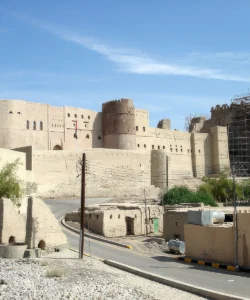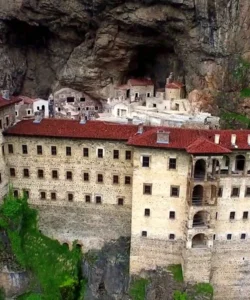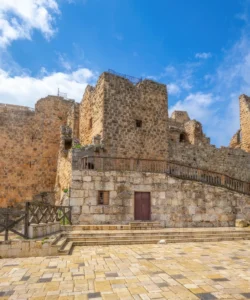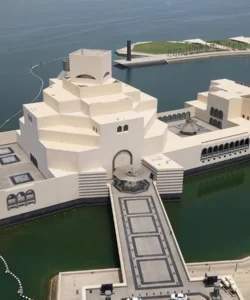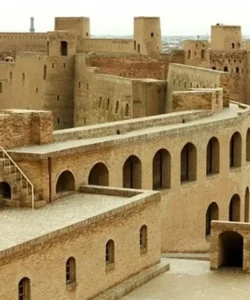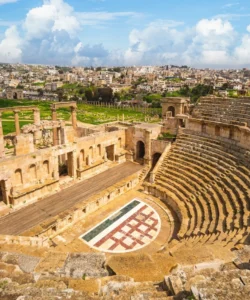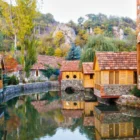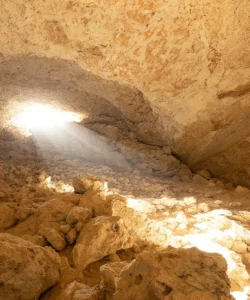Aghtamar Cathedral (Armenian: Սուրբ Խաչ եկեղեցի, Surp Khachʿ egeghetsʿi, meaning Cathedral of the Holy Cross; Turkish: Akdamar Kilisesi) is a medieval Armenian Apostolic cathedral located on Akdamar Island in Lake Van, eastern Turkey. Built in the 10th century, it is celebrated for its exquisite bas-relief carvings and its stunning island setting.
Listen to an introduction about Aghtamar Cathedral
Name and Address
- Name: Cathedral of the Holy Cross (also Aghtamar Cathedral, Surp Khach Church, or Akdamar Church). The island’s name, Aghtamar, is linked to a local legend of a nobleman who drowned in the lake calling out “Ach, Tamar!” (Oh, Tamar!) for his beloved.
- Address: Akdamar Island, Lake Van, Van Province, Eastern Anatolia, Turkey.
- Location: Situated on Akdamar Island, the second largest of four islands in Lake Van, approximately 45 km (28 miles) from the city of Van. The island itself is a small rise in the lake, offering picturesque views of the surrounding water and snowy mountains.
How to Get There
Aghtamar Cathedral is a popular and scenic destination, requiring a boat trip to reach the island:
- To Van City:
- By Plane: Van Ferit Melen Airport (VAN) has daily flights from major Turkish cities like Istanbul and Ankara.
- By Bus: Buses connect Van to various cities across Turkey.
- By Train: Train services connect to Tatvan (on the western shore of Lake Van), from where you can take a bus or ferry to Van.
- To Aghtamar Island (from Van City):
- To Gevaş Pier: Take a dolmuş (minibus) from Van city center to Gevaş (also spelled Gevash), which is about 44 km (27 miles) southwest of Van. The journey takes about an hour.
- Boat to Island: From Gevaş, regular boat services (typically taking 20 minutes) transport visitors the 3 km (2 miles) across the lake to Akdamar Island. Boats usually wait to fill up before departing.
- Visitor Information:
- Entrance Fee: There is an entrance fee for the church, in addition to the boat fare to the island.
- Hours: Typically open daily from 8:00 AM to 5:00 PM or 7:00 PM, depending on the season. It’s advisable to check locally for the most current hours.
Landscape and Architecture
Aghtamar Cathedral is a masterpiece of Armenian architecture, renowned for its unique design and rich sculptural decoration, set against the stunning backdrop of Lake Van.
- Architectural Style: Built between 915 and 921 AD by the architect-monk Manuel for King Gagik I Artsruni of Vaspurakan, the church is a “Hripsime-type” tetraconch (four-lobed clover-like, cross-shaped plan) with a central dome and conical roof. This form was developed in Armenia centuries earlier.
- Materials: Constructed from pink volcanic tuff (tufa) stone, which gives the church its warm hue, blending beautifully with the natural colors of the island.
- Exquisite Bas-Reliefs: The most distinctive feature of Aghtamar Cathedral is the extensive array of bas-relief carvings that adorn its entire exterior walls. These intricate stone reliefs depict a wide range of themes, including:
- Biblical Scenes: Stories from the Old and New Testaments, such as Adam and Eve, Jonah and the Whale, David and Goliath, Abraham and Isaac, and St. George slaying a dragon.
- Figural and Narrative Scenes: Depictions of Christ Pantocrator, Madonna and Child, King Gagik I presenting a model of the church to Christ, and even scenes of daily life, hunting, and palace life.
- Animals, Flora, and Geometric Patterns: A richly carved border runs around the entire cathedral, populated with animals and figures that may represent the Months of the Year.
- Interior: The interior once featured beautiful frescoes, though only faint remains survive today.
- Island Setting: The church is situated on a small rise on Akdamar Island, offering breathtaking views of Lake Van and the surrounding snowy mountains. The island itself is dotted with almond trees, adding to its picturesque charm.
- Monastic Complex: In later centuries, and until 1915, the cathedral was part of a larger monastic complex, the ruins of which can still be seen to the south of the church. Between 1116 and 1895, it served as the seat of the Armenian Catholicosate of Aghtamar.
What Makes It Famous
Aghtamar Cathedral’s fame is deeply rooted in its unique artistic and architectural qualities, as well as its historical significance:
- Masterpiece of Armenian Art: It is considered one of the most important surviving examples of medieval Armenian religious architecture and decorative art, particularly for its innovative and profuse exterior sculptural imagery.
- Extensive Bas-Reliefs: The sheer quantity, detail, and narrative scope of its external bas-relief carvings are unparalleled in Armenian architecture and are a major reason for its renown. These reliefs offer insights into both religious and secular life of the 10th century.
- Stunning Island Location: Its dramatic and beautiful setting on Akdamar Island in Lake Van makes it an exceptionally picturesque and memorable site.
- Historical Significance: Built as a palatine church for the kings of Vaspurakan, it later became a significant center of the Armenian Apostolic Church as the seat of the Catholicosate of Aghtamar.
- Cultural Crossroads: The reliefs are believed to show a fascinating blend of Armenian, Byzantine, Sassanid, and even some Abbasid (Islamic) influences, reflecting the cultural diversity of the Vaspurakan Kingdom.
Differences from Other Landmarks
Aghtamar Cathedral distinguishes itself from other historical sites in Armenia (and the broader region) in several key ways:
- Location Outside Modern Armenia: Unlike the monasteries and cathedrals located within the Republic of Armenia (like Geghard, Tatev, Noravank, Etchmiadzin, Zvartnots), Aghtamar Cathedral is situated in Eastern Turkey, representing a significant part of historical Armenian heritage now across the border.
- Profusion of Exterior Bas-Reliefs: While other Armenian churches feature intricate carvings and khachkars, Aghtamar’s fame rests uniquely on the unprecedented richness and sculptural quality of its exterior bas-reliefs covering almost all facades, which is a rare innovation in Christian architecture of its time.
- Island Setting: Its location on an island in a large lake (Lake Van) is a distinct feature, requiring a boat trip to access, offering a unique visitor experience compared to mainland monasteries or urban sites.
- Palatine Church Origin: It was originally built as a palatine (royal) church for the kings of Vaspurakan, giving it a specific historical context different from monasteries founded purely for monastic life or as pilgrimage sites from the outset.
- Hripsime-Type Plan with Unique Decoration: While its architectural plan (tetraconch) is similar to the 7th-century St. Hripsime Church in Etchmiadzin, Aghtamar’s unique importance comes from how this form is adorned with its extensive and diverse sculptural program.
Aghtamar Cathedral Photos:































